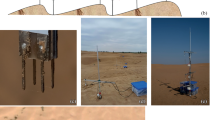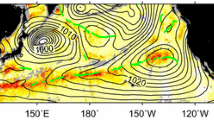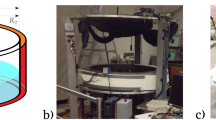Abstract
Ensemble averages of temperature before and after step-like temperature fluctuations reveal the presence of inverted ramps in a stable surface layer. Normalized frequency of upward steps increases with increasing stability, whereas normalized magnitude of the temperature step decreases with stability and becomes constant at about R i = 1. These results suggest that the significance of temperature steps increases as stability increases. In moderate stability, the temperature pattern shows a gradual decrease after an upward step, which can be called a time-inverted ramp. Descending air and large downward heat flux are observed in a time-inverted ramp, suggesting a contribution from an ordered motion in wind. On the other hand, the temperature steps are related to gravity waves in strong stability.
Similar content being viewed by others
References
Antonia, R. A., Chambers, A. J., Friehe, C. A., and Van Atta, C. W.: 1977, ‘Temperature Ramps in the Atmospheric Surface Layer’, J. Atmos. Sci. 36, 99–108.
Antonia, R. A., Rajagopalan, S., and Chambers, A. J.: 1983, ‘Conditional Sampling of Turbulence in the Atmospheric Surface Layer’, J. Climate and Appl. Meteorol. 22, 69–78.
Chiba, O.: 1984, ‘Height Dependence of the Scale of Turbulence and Higher-Order Moments of the Vertical Wind Velocity in the Neutral Atmospheric Surface Layer’, J. Met. Soc. Japan 62, 312–322.
Chiba, O. and Kikuchi, T.: 1982, ‘A Semiempirical Formula for the Vertical Wind Velocity Skewness in the Unstable Atmospheric Surface Layer’, Tenki 29, 1213–1220 (in Japanese).
Kaimal, J. C. and Businger, J. A.: 1970, ‘Case Studies of a Convective Plume and Dust Devil’, J. Appl. Meteorol. 9, 612–620.
Kaimal, J. C., Wyngaard, J. C., Izumi, Y., and Coté, O. R.: 1972, ‘Spectral Characteristics of Surface-Layer Turbulence’, Quart. J. R. Meteorol. Soc. 98, 563–589.
Kline, S. J., Reynolds, W. C., Schraub, F. A., and Runstadler, P. W.: 1967, ‘The Structure of Turbulent Boundary Layers’, J. Fluid Mech. 30, 741–773.
Kondo, J., Kanechika, O., and Yasuda, N.: 1978, ‘Heat and Momentum Transfer under Strong Stability in the Atmospheric Surface Layer’, J. Atmos. Sci. 35, 1012–1021.
Kovasznay, L. S. G., Kibens, V., and Blackwelder, R. F.: 1970, ‘Large-scale Motion in the Intermittent Region of a Turbulent Boundary Layer’, J. Fluid Mech. 41, (2) 283–325.
Phong-anant, D., Antonia, R. A., Chambers, A. J., and Rajagopalan, S.: 1980, ‘Features of the Organized Motion in the Atmospheric Surface Layer’, J. Geophys. Res. 85, 424–432.
Saito, M. and Ishii, Y.: 1969, ‘Simple Recursive Filter’, Butsuri-tanko (Geophysical Exploration) 22, 527–532 (in Japanese).
Wallace, J. M., Eckelmann, H., and Brodkey, R. S.: 1972, ‘The Wall Region in Turbulent Shear Flow’, J. Fluid Mech. 60, 39–48.
Wallace, J. M., Brodkey, R. S., and Eckelmann, H.: 1977, ‘Pattern-Recognized Structures in Bounded Turbulent Shear Flows’, J. Fluid Mech. 83, (4) 673–639.
Author information
Authors and Affiliations
Rights and permissions
About this article
Cite this article
Kikuchi, T., Chiba, O. Step-like temperature fluctuations associated with inverted ramps in a stable surface layer. Boundary-Layer Meteorol 31, 51–63 (1985). https://doi.org/10.1007/BF00120034
Accepted:
Issue Date:
DOI: https://doi.org/10.1007/BF00120034




